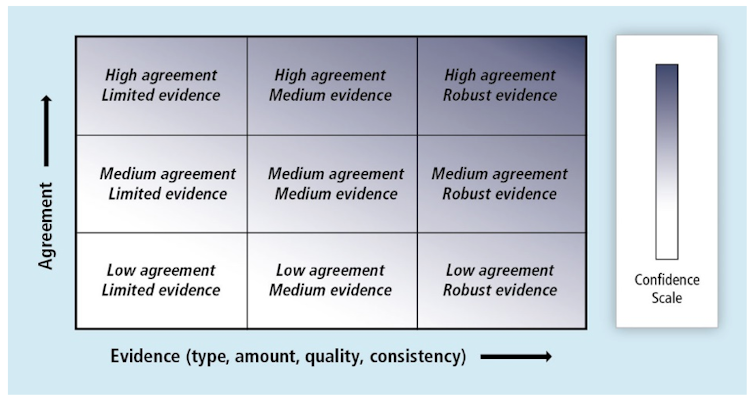The Intergovernmental Panel on Climate Change (IPCC) is the accepted global authority on climate change. It produces reports that are collectively agreed assessments of the scientific literature by leading researchers. The Fifth Assessment Report (AR5) is being delivered over 2013–2014, starting this weekend.
What an IPCC report is
An Intergovernmental Panel on Climate Change (IPCC) report is an assessment that collects and summarises current knowledge in relation to climate change. This is done using literature from peer reviewed and unreviewed (grey) sources.
It is considered the leading review globally of climate change and is produced by a team of hundreds of scientists and specialists from a diverse range of disciplines.
The three key areas examined in the AR5 are:
- the physical science - Working Group I (September 2013)
- impacts, vulnerabilities and adaptation - Working Group II (March 2014)
- mitigation options scenarios - Working Group III (April 2014)
A final synthesis report,to be released in October 2014, will provide an overview of all of these areas.
What an IPCC report is not
The IPCC report is not original research – it is an assessment of current research by researchers and experts.
The IPCC assessment reports are not made to dictate policy and decision making but to assist it. These reports do not make policy recommendations but may assess aspects of policy on behalf of the country members of the IPCC.
The purpose of the report
The key purpose of this report is to provide comprehensive scientific assessments of current scientific, technical and socio-economic information worldwide in relation to the causes, resulting impacts of and possible solutions to climate change. It is also to create greater understanding of climate change to enable effective decision and policy making globally and locally.
The language
Much of the report is written in scientific language that aims to deliver precise scientific information. Much of this language is dense, and at times highly technical, to ensure precise meanings are maintained.
This is partly to try to minimise the misinterpretation and inappropriate use of key findings. This also means that readers of this report will need to have a level of scientific literacy to be able to interpret the full reports effectively.
The Summary for Policymakers and Technical Summaries are intended to be more accessible, but still require careful interpretation.
The context for uncertainty
Uncertainty in the context of these reports does not mean that the scientists are unsure of their findings. Uncertainty is a key part of how key scientific conclusions are reached and communicated. In the context of these reports scientific uncertainty is presented as a measure of confidence in the validity of a finding and/or the likelihood of that finding.
Confidence is expressed qualitatively, which is expressed as levels of agreement and evidence.

Likelihood deals with how likely key findings are thought to be true and follow the scale below.

Scenarios, projection and prediction
A scenario is a plausible description of how the future may develop based on a coherent and internally consistent set of assumptions about key driving forces (such as rate of technological change, prices) and relationships. Scenarios are neither predictions nor forecasts. They provide a view of possible outcomes and the implications of developments and actions.
A scientific projection is a potential future evolution of a quantity or set of quantities. It is often computed with the aid of a model. Projections involve forming judgements using assumptions about a set of qualities that may or may not occur in the way they are assumed to; for example, the rate of social or economic change in a region.
A climate prediction or climate forecast attempts to produce (starting from a particular state of the climate system) an estimate of how the climate will appear in the future.
What is a Representative Concentration Pathway?
The Representative Concentration Pathways (RCPs) are four projected pathways of future changes in radiative forcing (changes of energy balance in the atmosphere that cause cooling or heating). They span a range of possibilities from low to high emissions. They were designed to cover the range of published greenhouse emission scenarios.
The key purpose of the pathways is to provide a consistent basis for comparing different model-based experiments using climate, impacts and integrated assessment models. They are the foundation for a new generation of scenarios where various emissions pathways can be combined with socio-economic storylines to test different policy, technology, economic and societal assumptions.
Key considerations in reading this report
Due to the nature of establishing a scientific consensus from a wide range of scientific opinion, the findings of these reports are considered conservative by many researchers.
The climate system is dynamic and complex. As a result, conclusions drawn from reading IPCC reports that are not informed by sufficient expertise may not represent findings accurately. It is advised that, when unsure, seek advice from a suitably qualified person.

